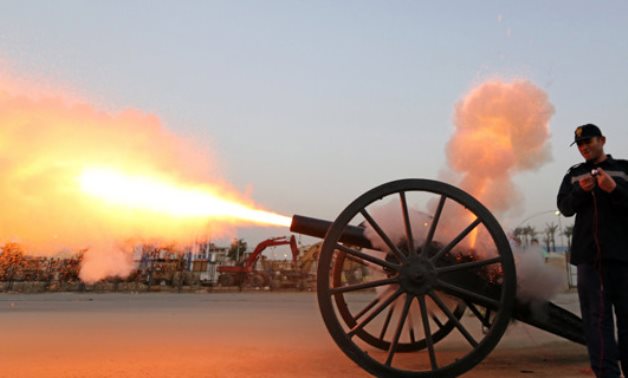
An Egyptian policeman in Cairo fires a cannon to announce the time to break fast during Ramadan. (REUTERS file photo)
CAIRO - 13 April 2020: After nearly 30 years of silence, the Ramadan cannon fires again on the first day of the holy month of Ramadan to declare the time Muslim Egyptians break their fast from the square of the Police Museum in Salah El-Din Castle in Cairo. The canon had been restored by the Ministry of Tourism and Antiquities.
Although it has been halted for 30 years, the Iftar Cannon has remained in the hearts and minds of Egyptians, as it has become a well-established tradition of the holy month.
Many stories have spread regarding the truth of the story of Ramadan Cannon; however, all confirm that it originated in the city of Cairo, specifically the Citadel of Salah al-Din in Cairo.
One of the accounts narrates that the Ramadan cannon dates back to the reign of the Mamluk Sultan Khuskadam; the sultan wanted to test a new cannon and that coincided with the sunset of the first day of Ramadan in 1467 AD.
People thought that the Sultan had deliberately fired the cannon to inform the fasting people that the time for breakfast had come, so crowds of people went out to the government headquarters to thank him for this good gesture. Accordingly, he decided to go ahead with firing the cannon every day during Ramadan.
Another story said that some soldiers during the reign of Khedive Ismail were testing one of the cannons, and a shell exploded ringing in the sky of Cairo at the time of the sunset call to prayer on the first day of Ramadan.
People thought that the Khedive is setting a tradition to announce the time for breakfast, so they started talking about it, and when Hajjah Fatima, daughter of Khedive Ismail, learned what had happened, she liked the idea.
Hajjah Fatima asked the Khedive to issue a decree declaring the firing of the cannon a new Ramadan habit; hence the cannon was known at the time known as Hajjah Fatima's cannon. Later, the cannon would also be fired for suhoor and official holidays.
It is believed that the cannon was changed more than once and moved to more than one place.
The cannon is originally a Krupp brand cannon produced in 1871 AD; it was operated by two soldiers, one of them puts gunpowder in the mouth of the iron tube and the other launches the shell.
Assistant Minister of Tourism and Antiquities for the Development of Museums and Archaeological Sites, Iman Zidan, explained that the restoration work of the cannon comes within the framework of the ministry's plan to raise the efficiency of tourism services in museums and archaeological sites, including the Citadel of Salah al-Din al-Ayyubi.
She pointed out that the cannon strikes again at sunset every day throughout the month of Ramadan, to preserve the archaeological heritage of the castle while keeping pace with modern technology by firing a laser beam next to the cannon extending to a far distance.
Secretary-General of the Supreme Council of Antiquities Mustafa Waziri explained that the work of repairing the cannon included removing the layer of rust formed on the cannon's body and cleaning it from the inside.
Comments
Leave a Comment